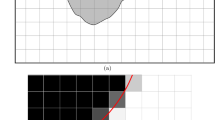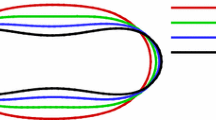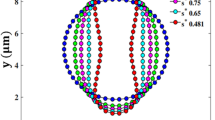Abstract
The hemodynamic interactions of red blood cells (RBCs) in a microcapillary flow are investigated in this paper. This kind of interaction is considered as the non-contact mutual interaction of cells, which is important in the suspension flow of blood, but not sufficiently understood. The distributed Lagrange multiplier/fictitious domain method in the lattice Boltzmann framework is used to solve the suspension of the RBCs. The modification of the flow due to the cells, the dependence of the cell deformation on the flow and the cell-cell interaction via the fluid are discussed. It is revealed that the long-range hydrodynamic interaction with a long interacting distance, more than about 5 times of the RBC equivalent radius, mainly has effect on the rheology properties of the suspension, such as the mean velocity, and the short-range interaction is sensitive to the shape of the cell in the microcapillary flow. The flow velocity around the cell plays a key role in the cell deformation. In the current configuration of the flow and cells, the cells repel each other along the capillary.
Similar content being viewed by others
References
ZHU C., YAGO T. and LOU J. et al. Mechanisms for flow-enhanced cell adhesion[J]. Annals of Biomedical Engineering, 2008, 36(4): 604–621.
KHSMATULLIN D. B., TRUSKEY G. A. Three-dimensional numerical simulation of receptor-mediated leukocyte adhesion to surfaces: effects of cell deforma-bility and viscoelasticity[J]. Physics of Fluids, 2005, 17: 031505.
FISCHER T. M. Tank-tread frequency of the red cell membrane: Dependence on the viscosity of the suspending medium[J]. Biophysical Journal, 2007, 93(7): 2553–2561.
NOGUCHI H. Swinging and synchronized rotations of red blood cells in simple shear flow[J]. Physical Review E, 2009, 80(2): 021902.
ZHANG J., JOHNSON P. C. and POPEL A. S. Red blood cell aggregation and dissociation in shear flows simulated by lattice Boltzmann method[J]. Journal of Biomechanics, 2008, 41(1): 47–55.
SHI L., PAN T-W. and GLOWINSINSKI R. Deformation of a single red blood cell in bounded Poiseuille flows[J]. Physical Review E, 2012, 85(1): 016307.
AIDUN C. K., CLAUSEN J. R. Lattice Boltzmann method for complex flows[J]. Annual Review of Fluid Mechanics, 2010, 42: 439–472.
DUARTE F., GORMAZ R. and NATESAN S. Arbitrary Lagrangian-Eulerian method for Navier-Stokes equations with moving boundaries[J]. Computer Methods in Applied Mechanics and Engineering, 2004, 193: 4819–4836.
POZRIDIS C. Axisymmetric motion of a file of red blood cells through capillaries[J], Physics of Fluids, 2005, 17(3): 031503.
ANDERSON W. An immersed boundary method wall model for high-Reynolds-number channel flow over complex topography[J]. International Journal for Numerical Methods in Fluid, 2013, 71(12): 1588–1608.
LIU Y., LIU W. K. Rheology of red blood cell aggregation by computer simulation[J]. Journal of Computational Physics, 2006, 220(1): 139–154.
BAAIJENS F. P. T. A fictitious domain/mortar element method for fluid-structure interaction[J]. International Journal for Numerical Methods in Fluid, 2001, 35(7): 743–761.
ZHANG J., JOHNSON P. C. and POEL A. S. Effects of erythrocyte deformability and aggregation on the cell free layer and apparent viscosity of microscopic blood flows[J]. Microvascular Research, 2009, 77(3): 265–272.
YE T., LI H. and LAM K. Y. Modeling and simulation of microfluid effects on deformation behavior of a red blood cell in a capillary[J]. Microvascular Research, 2010, 80(3): 453–463.
ZHAO H., ISFAHANI A. H. G. and OLSON L. N. et al. A spectral boundary integral method for flowing blood cells[J]. Journal of Computational Physics, 2010, 229(10): 3726–3744.
SHI X., LIM S. P. A LBM-DLM/FD method for 3D fluid-structure interactions[J] Journal of Computational Physics, 2007, 226(2): 2028–2043.
FUNG Y. C. Biomechanics: mechanical properties of living tissues[M]. 2nd Edition, New York, USA: Springer-Verlag, 1993.
TSUKADA K., SEKIZUKA E. and OSHIO C. Direct measurement of erythrocyte deformability in diabetes mellitus with transparent microchannel capillary model and high-speed video camera system[J]. Microvascular Research, 2001, 61(3): 231–239.
LI J., DAO M. and LIM C. T. et al. Spectrin-level modeling of the cytoskeleton and optical tweezers stretching of the erythrocyte[J]. Biophysical Journal, 2005, 88(5): 3707–3719.
FEDOSOV D., CASWELLL B. and KARNIADAKIS G. E. A multiscale red blood cell model with accurate mechanics, rheology, and dynamics[J]. Biophysical Journal, 2010, 98(10): 2215–2225.
YU Z.. Journal of Computational Physics, 2005, 207(1): 1–27.
NOURGALIEV R. R., DINH T. N. and THEOFANOUS T. G. et al. The lattice Boltzmann equation method: Theoretical interpretation, numerics and implications[J]. International Journal of Multiphase Flow, 2003, 29(1): 117–169.
Author information
Authors and Affiliations
Corresponding author
Additional information
Project supported by the National Natural Science Foundation of China (Grant Nos. 11372278, 10902098), the Fundamental Research Funds of the Central Universities (Grant No. 2010QNA40107).
Biography: SHI Xing (1975-), Male, Ph. D., Associate Professor
Rights and permissions
About this article
Cite this article
Shi, X., Zhang, S. & Wang, Sl. Numerical simulation of hemodynamic interactions of red blood cells in microcapillary flow. J Hydrodyn 26, 178–186 (2014). https://doi.org/10.1016/S1001-6058(14)60020-2
Received:
Revised:
Issue Date:
DOI: https://doi.org/10.1016/S1001-6058(14)60020-2




